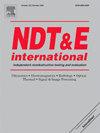基于移动对比x射线成像的像素级缺陷无损检测
IF 4.1
2区 材料科学
Q1 MATERIALS SCIENCE, CHARACTERIZATION & TESTING
引用次数: 0
摘要
x射线成像在工业和研究中广泛应用于缺陷检测。然而,传统的x射线成像方法难以在噪声或散射主导的环境中实现对像素级缺陷(1-3像素)的高灵敏度,例如金属工件或厚的低z材料。为了解决这个问题,我们引入了移动对比x射线成像(MCXI),它利用样品和成像系统之间的相对运动来抑制噪声并提高复杂背景下弱信号检测的灵敏度。MCXI已成功应用于生物医学成像和高分辨率材料研究等领域,显示出显著的抗噪声和灵敏度提高。本文将MCXI扩展到静态样本缺陷的检测中,旨在解决高噪声和复杂背景下像素级检测的难题。数值模拟验证了MCXI的单像素缺陷检测能力。同步辐射实验通过对低对比度聚氯乙烯(PVC)样品中1.54像素缺陷(1-μm聚苯乙烯球)的定量表征验证了该技术,实现了26.12的CNR,比直接投影成像提高了14.04倍。通过对81.2 μm缺陷(8.12像素)的合金钢管进行测试,验证了该方法的工业适用性,其中MCXI在实验室x射线系统中实现了15.16(8.1倍增强)的CNR。MCXI与同步加速器设备和工业x射线机的无缝集成,再加上其抗噪声特性,为在具有强散射和复杂背景的挑战性环境中进行高灵敏度无损检测建立了通用解决方案。本文章由计算机程序翻译,如有差异,请以英文原文为准。
Nondestructive testing of defects at pixel level with move contrast X-ray imaging
X-ray imaging is broadly applied for defect detection in industry and research. However, traditional X-ray imaging methods struggle to achieve high sensitivity for pixel-level defects (1–3 pixels) in noisy or scattering-dominated environments, such as metal workpieces or thick low-Z materials. To address this, we introduce move contrast X-ray imaging (MCXI), which leverages relative motion between the sample and imaging system to suppress noise and enhance the sensitivity of weak signal detection in complex backgrounds. MCXI has been successfully applied in fields such as biomedical imaging and high-resolution material studies, demonstrating significant noise resistance and sensitivity improvements. This paper extends MCXI to the testing of defects in static samples, aiming to solve the challenges of detecting pixel-level in high-noise and complex backgrounds. Numerical simulations demonstrate MCXI's capability for single-pixel defect detection. Synchrotron radiation experiments validate this technique through quantitative characterization of 1.54-pixel defects (1-μm polystyrene spheres) in low-contrast polyvinyl chloride (PVC) samples, achieving a CNR of 26.12 - representing a 14.04 × improvement over direct projection imaging. The method's industrial applicability is demonstrated through alloy steel pipe testing with 81.2 μm defects (8.12 pixels), where MCXI achieves a CNR of 15.16 (8.1 × enhancement) using laboratory-based X-ray systems. MCXI's seamless integration with both synchrotron facilities and industrial X-ray machines, combined with its noise-resistant characteristics, establishes a universal solution for high-sensitivity nondestructive testing in challenging environments with strong scattering and complex backgrounds.
求助全文
通过发布文献求助,成功后即可免费获取论文全文。
去求助
来源期刊

Ndt & E International
工程技术-材料科学:表征与测试
CiteScore
7.20
自引率
9.50%
发文量
121
审稿时长
55 days
期刊介绍:
NDT&E international publishes peer-reviewed results of original research and development in all categories of the fields of nondestructive testing and evaluation including ultrasonics, electromagnetics, radiography, optical and thermal methods. In addition to traditional NDE topics, the emerging technology area of inspection of civil structures and materials is also emphasized. The journal publishes original papers on research and development of new inspection techniques and methods, as well as on novel and innovative applications of established methods. Papers on NDE sensors and their applications both for inspection and process control, as well as papers describing novel NDE systems for structural health monitoring and their performance in industrial settings are also considered. Other regular features include international news, new equipment and a calendar of forthcoming worldwide meetings. This journal is listed in Current Contents.
 求助内容:
求助内容: 应助结果提醒方式:
应助结果提醒方式:


